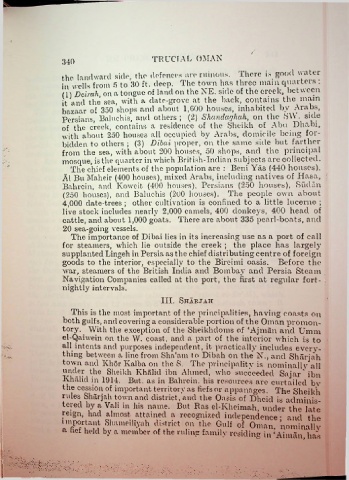Page 326 - A Hand book of Arabia Vol 1 (iii) Ch 6 -10
P. 326
(
340 TRUCfAL OMAN
the landward side, the defences are ruinous. There is good water
in wells from 5 to 30 ft. deep. The town has three mam quarters .
(1) Deirah, on a tongue of land on the NE. side of the creek, between
it and the sea, with a date-grove at the back, contains the main
bazaar of 350 shops and about 1,600 houses, inhabited by Arabs,
Persians, Baluchis, and others ; (2) Shandaghah, on the S\V. side
of the creek, contains a residence of the Sheikh of Abu Dhabi,
with about 250 houses all occupied by Arabs, domicile being for
bidden to others ; (3) Dibai proper, on the same side but farther
from the sea, with about 200 houses, 50 shops, and the principal
mosque, is the quarter in which British-Indian subjects are collected.
The chief elements of the population are : Beni Yas (440 houses).
A1 Bu Maheir (400 houses), mixed Arabs, including natives of Hasa,
Bahrein, and Ivoweit (400 houses), Persians (250 houses), Sudan
(250 houses), and Baluchis (200 houses). The people own about
4,000 date-trees ; other cultivation is confined to a little lucerne ;
live stock includes nearly 2,000 camels, 400 donkeys, 400 head of
cattle, and about 1,000 goats. There are about 335 pearl-boats, and
20 sea-going vessels.
The importance of Dibai lies in its increasing use as a port of call
for steamers, which lie outside the creek ; the place has largely
supplanted Lingeh in Persia as the chief distributing centre of foreign
goods to the interior, especially to the Bireimi oasis. Before the
war, steamers of the British India and Bombay and Persia Steam
Navigation Companies called at the port, the first at regular fort I
nightly intervals.
III. Sharjah
This is the most important of the principalities, having coasts on
both gulfs, and covering a considerable portion of the Oman promon
tory. With the exception of the Sheikhdoms of ‘Ajman and Umm
el-Qaiwein on the W. coast, and a part of the interior which is to
all intents and purposes independent, it practically includes every
thing between a line from Sha'am to Dibah on the N., and Sharjah
town and Ivhor Kalba on the S. The principality is nominally all
under the Sheikh Khalid ibn Ahmed, who succeeded Sajar' ibn
Ivhalid in 1914. But. as in Bahrein, his resources are curtailed bv
the cession of important territory as fiefs or appanages. The Sheikh
rules Sharjah town and district, and the Oasis of Dheid is adminis
tered by a Vali in his name. But Ras el-Kheimah, under the late
reign, had almost attained a recognized independence- and the
a'fMh'n k1l'“me!l!-';ah dhVict ?n *l,c GjP ot Oman, nominally
a hef held by a member of the ruling family residing in ‘Annan, has
*. •

